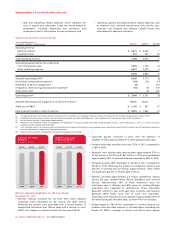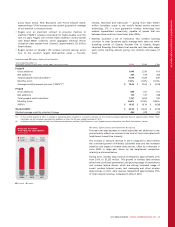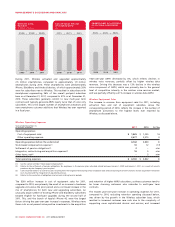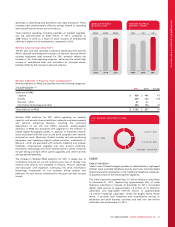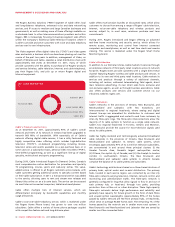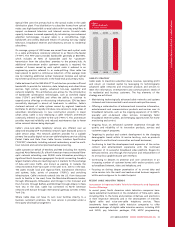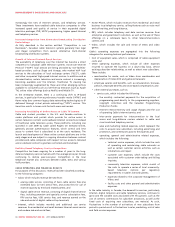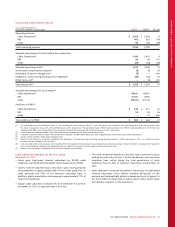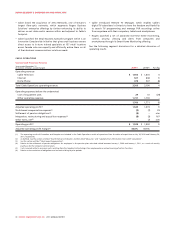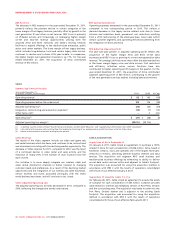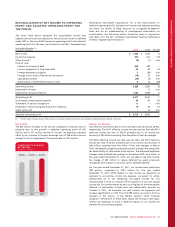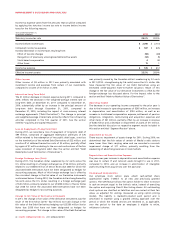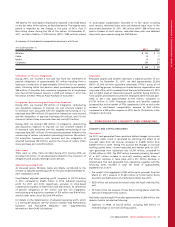Rogers 2011 Annual Report Download - page 42
Download and view the complete annual report
Please find page 42 of the 2011 Rogers annual report below. You can navigate through the pages in the report by either clicking on the pages listed below, or by using the keyword search tool below to find specific information within the annual report.
MANAGEMENT’S DISCUSSION AND ANALYSIS
Cable Television Revenue
The increase in Cable Television revenue for 2011, compared to 2010,
reflects the continuing increase in penetration of our digital cable
product offerings and pricing changes. The increase in the year-over-
year growth rate of Cable Television revenue from 2010 to 2011
partially reflects the timing of annual pricing changes, which took
place in July 2010 and March 2011, combined with the cumulative
effect of targeted bundling and retention initiatives to transition
portions of the subscriber base to term contracts and a lower number
of subsidized digital box sales.
The digital cable subscriber base grew by 3% and represented 77% of
television households passed by our cable networks as at
December 31, 2011, compared to 75% as at December 31, 2010.
Increased demand from subscribers for the larger selection of digital
content, video on-demand, HDTV and PVR equipment continues to
contribute to the growth in the digital subscriber base and cable
television revenue.
Cable expects to begin a substantial conversion of the remaining
analog cable customers onto its digital cable platform during 2012
and 2013. This migration will enable the reclamation of significant
amounts of network capacity as well as reduce network operating
and maintenance costs going forward. The migration will entail
incremental PP&E and operating costs as each of the remaining
analog homes are fitted with digital converters and various analog
filtering equipment is removed.
(In thousands)
DIGITAL HOUSEHOLDS AND
PENETRATION OF TELEVISION
CUSTOMERS
1,6641,733 1,777
2009 20102011
72% 75% 77%
(In thousands)
HIGH-DEFINITION
HOUSEHOLDS
715 850 942
2009 20102011
Cable Internet Revenue
The year-over-year increase in Internet revenue for 2011 primarily
reflects the increase in the Internet subscriber base, combined with
Internet services price changes made over the previous twelve
months. Also impacting the increase is the timing and mix of
promotional programs and a general movement by subscribers
towards higher end tiers and a modest increase in revenue from
additional usage.
With the high-speed Internet customer-base at approximately
1.8 million subscribers, Internet penetration is approximately 48% of
the homes passed by our cable networks and 78% of our television
subscriber base, as at December 31, 2011.
(In thousands)
INTERNET SUBSCRIBERS
AND PENETRATION
OF HOMES PASSED
1,6191,6861,793
2009 20102011
45% 45% 48%
Home Phone Revenue
The year-over-year decrease in Home Phone revenue for 2011 reflects
the declines in revenue associated with the legacy circuit-switched
telephony base that Cable has divested over the past five quarters.
The decline was partially offset by the increase in the cable telephony
customer base combined with price changes in March 2011.
Home Phone revenue decreased year-over-year as a result of the
ongoing decline of the legacy circuit-switched telephony base,
partially offset by the growth in cable telephony lines of
approximately 5% for 2011. The decline of the legacy circuit-switched
telephony base included approximately 34,000 subscribers which were
migrated to a third party reseller during 2011, per the sale agreement
entered into during the third quarter of 2010, as discussed below. The
lower net additions of cable telephony lines in 2011 versus 2010 were
the result of lower sales activity as campaigns were less aggressive
compared to the prior year.
Cable telephony lines in service grew 5% from December 31, 2010 to
December 31, 2011. At December 31, 2011, cable telephony lines
represented 28% of the homes passed by our cable networks and
46% of television subscribers.
Cable continues to focus principally on growing its on-net cable
telephony line base. Therefore, it continues its strategy to
de-emphasize the off-net circuit-switched telephony business where
services cannot be provisioned fully over Rogers’ own network
facilities. During the third quarter of 2010, Cable announced that it
was divesting most of the assets related to the remaining circuit-
switched telephony operations. Under this arrangement, most of its
co-location sites and related equipment were sold. In addition, the
sale involved residential circuit-switched lines, with the customers
served by these facilities being migrated from Cable Operations to a
third party reseller. During 2011, approximately 34,000 of these
subscribers were migrated to third-party resellers. For the year ended
December 31, 2011 the revenue reported by Cable Operations
associated with the residential circuit-switched telephony business
being divested totalled approximately $15 million.
38 ROGERS COMMUNICATIONS INC. 2011 ANNUAL REPORT


